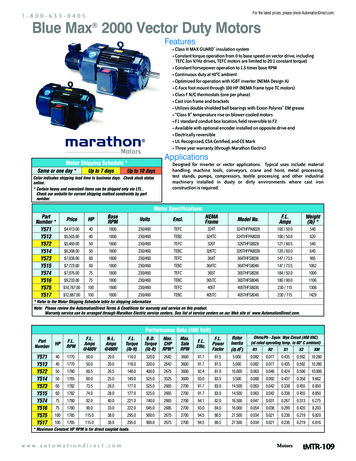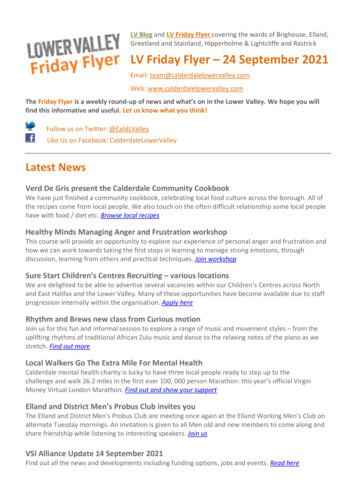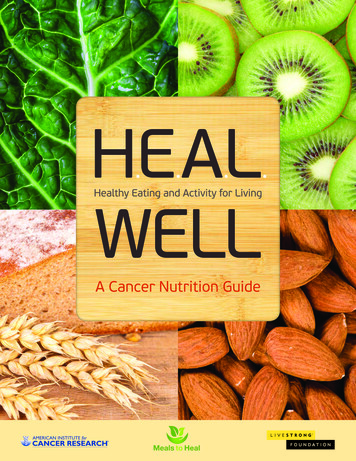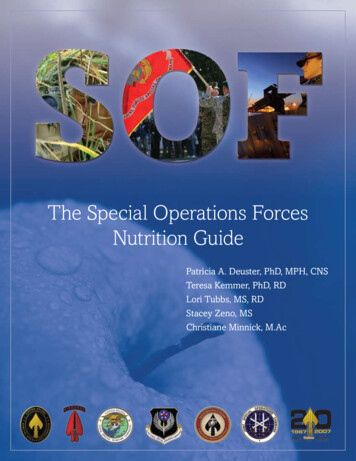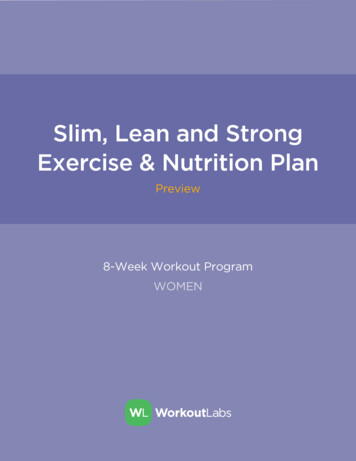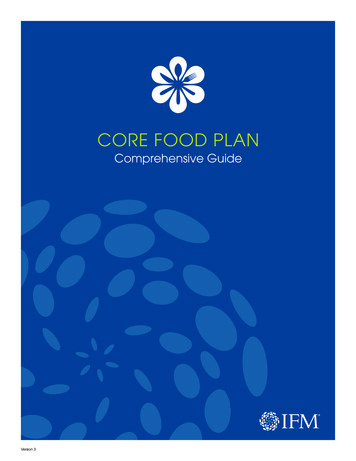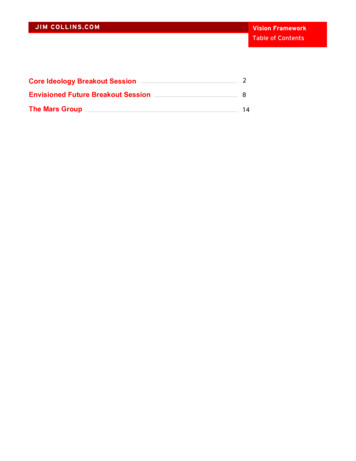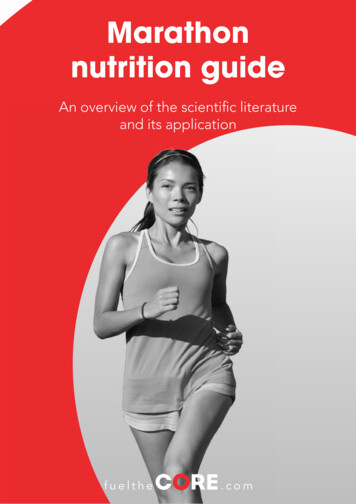
Transcription
Marathonnutrition guideAn overview of the scientific literatureand its application
Marathon – Nutrition guideWritten by Professor Asker JeukendrupAlthough nutrition is without doubt one of the most important aspects of racepreparation, athletes typically spend far more time thinking about training thanabout nutrition. In a marathon, nutrition can mean the difference between winning arace and not even finishing a race. Athletes who did not have a great run oftenblame nutrition: they ran out of energy, became dehydrated or experiencedstomach problems. They ingested too much, or ingested too little. They tried newproducts they had not used in training, and so on. This guide will give you theknowledge you need for a successful nutrition strategy. You can use the CORENutrition Planning tool (www.fuelthecore.com) to get a detailed personalizednutrition plan.Carbohydrates are the performance fuelThe body uses two main fuels: carbohydrate and fat. Fat is the primary fuel for lessintense exercise (low to moderate intensity: often referred to as aerobic) whilecarbohydrates are the primary fuel for intense exercise moderate to high intensity).Carbohydrate can deliver energy much faster to the muscles than fats. Thus,carbohydrates are the performance fuel, and fat is like “diesel” important for longerdistances at lower pace.The body has stores of both fuels, but unfortunately the stores for carbohydrate aremuch smaller than those of fat. Even the leanest athlete has sufficient fat to sustainthe longest races at moderate intensity (thousands of grams of fat). The typicalathlete will also have 500-800g of carbohydrates stored in muscle glycogen andliver glycogen (a small fraction versus fat stores); this is enough to fuel 2-3 hours ofintense exercise.Most marathon runners are familiar with “hitting the wall”; this is the point in themarathon when carbohydrate stores become depleted, usually around 20 miles or32 km. At this point the runner has only fat for fuel and intense performance cannotbe maintained (unless carbohydrates are consumed). There are a few simplestrategies that can delay or completely prevent this from happening. These copyright CORE Nutrition Planning LLC
strategies are making sure that you start the race with optimal muscle glycogenstores and liver glycogen stores and fueling during the race (using drinks, gelsand/or solid foods).Carb-loadingIn order to start a race with optimal glycogen stores it is important to eatcarbohydrate-rich in the day or days before the race (usually while also reducingtraining, which uses glycogen stores). Traditionally consuming additionalcarbohydrates has been called carbo-loading. Consuming a little morecarbohydrate than normal at the expense of some protein and fat will ensure thatyou are filling up your muscle glycogen stores, without gaining weight. Carboloading seems to get confused sometimes with overeating (eating as much aspossible). Good sources of carbohydrate include pasta, rice, potato and bread.Extreme supercompensation diets such as those used in the 1970s are notnecessary.BreakfastWhen you wake up in the morning the liver is virtually depleted of glycogen; thebody uses up the liver glycogen through the night. Because the liver providescarbohydrate to maintain your blood sugar and prevent hypoglycemia (low bloodsugar) during your race, it is essential to make sure you replenish liver glycogen.This is why breakfast is so important; breakfast replenishes liver glycogen stores. Agood pre-race breakfast includes 100-200 grams of carbohydrate in the 3-4 hoursbefore the start of your race. Some athletes find it difficult to eat before a race;they could benefit by getting their carbohydrates from drinks. Athletes whoexperience stomach problems frequently should avoid breakfasts that are high infiber, fat and protein. Individuals very prone to developing gastro-intestinalproblems may also want to avoid milk products (or use lactose free products)Good carbohydrate sources for race dayRefined grains (white rice)cooked cerealscorn/rice based cerealswhite bread, bagels (no seeded breads)pancakescooked veggies (no seeds)cooked potatoesripe bananas copyright CORE Nutrition Planning LLC
cooked fruits, applesauce/fruit blendslean meatrice cakeshoneysyruppulp-free juiceNutrition just before the startIn the 15-30 minutes before the start you can continue to top up liver glycogenstores. We recommend 20-30g (80-120 kcal) of carbohydrate with 90-180ml (3-6 floz) of water. Because food and drink will sit in the stomach for a while andabsorption takes time, most of the carbohydrate you ingest at his time will becomeavailable during the first part of the run. So, anything that is ingested shortly beforethe start is part of your nutrition during exercise. What foods are best is a matter ofpersonal preference, but gels and chews are very commonly used. Make sure youalso practice this in training.Nutrition during the raceMarathon nutrition requires a bit of planning. It is important to study what isavailable on course and develop a plan that takes into account foods and drinks youwill collect on course versus foods and drinks you will have to bring yourself. Duringlonger races your target carbohydrate intake should be higher than during shorterraces. In races over 2 hours, athletes can benefit from an intake of roughly 60grams of carbohydrate per hour. Do not try this for the first time in your marathon!You should transition from your current fueling levels towards 60g/h during training.Your gut will get used to this very quickly. Again, what foods and drinks are best is amatter of personal preference. The target of 60g/h can be achieved with manydifferent combinations of water, sports drink, gels, chews, bars, and regular foods.GeneralIt is important to realize that any foods (bars, gels, chews or other) need to beingested with sufficient water to make sure gastric emptying is fast and no stomachproblems developHere are some tips:-Take foods just before a feed station where you know water will be available.Then drink a couple of cups of waterCarbohydrate from solid foods copyright CORE Nutrition Planning LLC
Solid foods usually provide more carbohydrates per unit of weight and are thereforea very effective energy source to carry. Bars typically deliver 30-60g ofcarbohydrate and come in many different flavors and with varying levels of fat, fiberand protein. It is recommended to select energy bars that are low in fat, fiber andprotein as these ingredients will slow down gastric emptying and may contribute tostomach problems. Solid food is great in preventing an empty feeling in thestomach that many athletes experience during later stages of a race. One drawbackof bars, however, is that they can be difficult to chew while racing. A seconddrawback is that bars generally contain more carbohydrates than should beconsumed at one instance; this means a bar would need to be carried for someperiod while being consumed in smaller bites. For these reason, some athletesprefer to get their carbohydrates from gels or chews.GelsGels are a compact form of energy. A small volume of fluid with a relatively largeamount of carbohydrates. Gels typically deliver 20-25 grams of carbohydrates andcome in many different flavors. Gels may be caffeinated or non-caffeinated. Theexact number of gels you need depends on your pace, the duration of exercise(race or training) and the amount of carbohydrates you get from other sources.ChewsChews are the middle ground between bars and gels. They are more solid thangels and are usually easier to consume than bars: easier to chew and come in singlebite pieces. Chews generally are 6-10g per piece, so 3 pieces typically is close to agel.Carbohydrate drinksCarbohydrate drinks typically contain carbohydrates in concentrations of 6-7%. Thismeans that the drink contains 60-70 grams of carbohydrates per liter of fluid. Aregular sports bottle of 600ml (20 oz.) will therefore deliver roughly 35 grams ofcarbohydrate. A sports drink also contains some sodium (and other electrolytes)which can be beneficial for the absorption of fluid (as we will see under hydration).Caffeine and performanceMany athletes use caffeine before or during a race to boost their performance. Thispractice is indeed supported by scientific evidence although there may beindividual differences in tolerance and perception. Studies have demonstrated thatrelatively small amounts of caffeine are required to give optimal effects (3mg perkilogram body weight; 200mg for a 70kg person). copyright CORE Nutrition Planning LLC
Because caffeine absorption takes 30-90 minutes, timing of caffeine is important.Studies have shown that caffeine ingested late in a race can still provide benefits.What works best is going to be highly individual and best established by trial anderror. There are many different ways to deliver caffeine: gels, colas, energy drinks,and coffee. The caffeine consumption for a race should conform to a person’snormal intake of caffeine. It is generally recommended not to exceed a daily intakeof 400 mg caffeine from all sources.Figure Caffeine sourcesCaffeinated gelsCola drinksEnergy drinksEspresso25-50mg per gel40-50 mg per 355 ml can50-100 mg per 250 can80-100 mg per cupDehydrationAnother cause of fatigue during a marathon is dehydration. In order to make surebody temperature stays within acceptable limits and we don’t overheat, we sweat.The faster we run, the more heat is produced and the more we need to sweat tostay cool. In hot conditions it is even more important because sweating may be theonly way we can cool down our bodies. When we lose too much sweat and becomedehydrated, it becomes harder to maintain our body temperature. Some degree ofdehydration is unlikely to be a problem but once you start to lose 3% of your bodyweight or more, performance may be affected.In order to prevent dehydration, it is important to start a race hydrated and maintainproper hydration throughout the race.Before the race, drink at least 500ml the 2 hours before the start; excess water willbe eliminated through urine. Double check your urine color is pale.During the race, your target for fluid intake should be such that you lose no morethan 3% body weight. This will always mean consuming fluid at a rate that is belowyour sweat rate (the longer the race, the closer to your sweat rate consumption willneed to be). Drink to thirst is a recommendation that works fine for the slowerathlete. If you are going a bit faster it is better to go in with a plan.It is wise to use the early parts of a race when the gastrointestinal tract is workingfine to absorb both carbohydrate and fluid. Later in the race, even though you maybe thirsty, the gut may not absorb as much. Don’t drink excessively, and usecommon sense. The goal should be to lose a little weight (1-2 kg) at the finish line.Athletes who want to be a little more prepared can work out how much they willsweat in the conditions of the race and use this to guide their drinking. If you want copyright CORE Nutrition Planning LLC
to find out how to best measure your sweat rate visit http://bit.ly/sweatrater. Don’tdrink excessively, and use common sense. All athletes definitely need to avoidweight gain, which clearly would be a sign of drinking too much, and that couldlead to a dangerous condition called hyponatremia.Don’t forget that good hydration starts before the race, and hydrate well in the daysleading to your race.If certain symptoms have arrived, there are some possible remedies during the race.It is important to note that when bloating occurs and fluids seems to accumulate inthe stomach there is no point ingesting more fluids. Reducing the intensity a littleand giving the stomach some time to pass fluid on to the intestine for absorptionand relieve bloating.TrainingOne of the most important aspects of preparation is “training your race nutrition”.Nutritional preparation should not start when you are walking around at the expothe day before your marathon! It should start at least 6-10 weeks before the raceand is important during your entire preparation phase. Training will always involve amix of hard and easy; same is true for nutrition. On easy days where quality oftraining is not so important and where you may purposely want to train your bodyto use fat as a fuel, you will consume little or no carbohydrate (“training low"). Onother days that are hard, where quality is important and where you want to trainyour body to perform just like you will in a race, it is a good idea to follow your raceplan.If you want a more personalized and more detailed nutrition plan, please visitwww.fuelthecore.com.Top tips Don’t experiment with new products on race day.Use the same nutrition products for at least 6 weeks prior to the race.Don’t be afraid to listen to your gut and when fluids are not emptying fromyour stomach reduce the intensity temporarily. You will benefit from this laterin the race.Hydration during the race is important, but make also sure you don’t start therace dehydratedPlan your breakfast on race day well in advance and make sure it is availablefor you on race day. Don’t just show up for breakfast in a hotel on race daywithout checking. copyright CORE Nutrition Planning LLC
Reading listBaker LB, Jeukendrup AE. Optimal composition of fluid-replacement beverages.Compr Physiol. 4(2):575-620, 2014.Burke LM, Hawley JA, Wong SH, Jeukendrup AE. Carbohydrates for training andcompetition. J Sports Sci. 29 Suppl 1:S17-27, 2011.Jeukendrup AE and Gleeson M. Sports nutrition 2nd edition Human KineticsChampaign IL. 2010 (ISBN-13: 978-0736079624, ISBN-10: 0736079629)Jeukendrup AE. Nutrition for endurance sports: marathon, triathlon, and roadcycling. J Sports Sci. 29 Suppl 1:S91-9, 2011.Jeukendrup A. A step towards personalized sports nutrition: carbohydrate intakeduring exercise. Sports Med. 44 Suppl 1:S25-33, 2014.de Oliveira EP, Burini RC, Jeukendrup A. Gastrointestinal complaints duringexercise: prevalence, etiology, and nutritional recommendations. Sports Med. 44Suppl 1:S79-85, 2014Asker Jeukendrup, PhD, FECSS, FACSMProfessor Asker Jeukendrup is a leading sports nutritionists and exercisephysiologist who spent most of his career at the University of Birmingham (UK) andcurrently he is a visiting professor at Loughborough University. During his careerProfessor Jeukendrup authored over 200 research papers and book chapters.During his career he worked with many elite athletes (including Chrissie Wellingtonand Haile Gebrselassie) to develop personalized nutrition plans to enhance recoveryand optimize performance. Asker practices what he preaches and is competing inlong distance triathlons himself. To date he completed 21 long distance triathlonraces. For more information on sports nutrition please visitwww.mysportscience.com or follow Asker on twitter: @jeukendrup. copyright CORE Nutrition Planning LLC
the start is part of your nutrition during exercise. What foods are best is a matter of personal preference, but gels and chews are very commonly used. Make sure you also practice this in training. Nutrition during the rac


